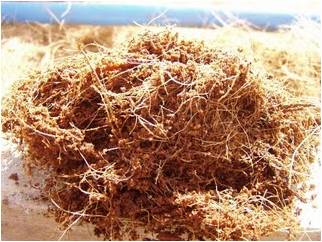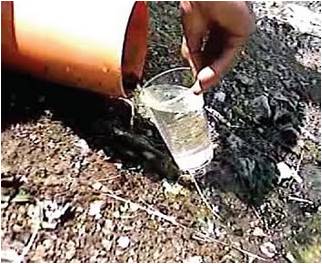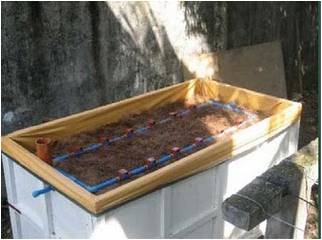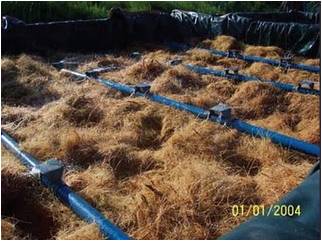Practitioner's Tool / Cocopeat Filters
Cocopeat is the dust from ground coconut shells once the fibers (coir) have been removed. It is generally considered to be a waste by-product from the coconut processing industry; therefore, in coconut producing areas, cocopeat is readily available at a low cost. The material has properties similar to sphagnum peat moss and has proven to be quite resilient in the wastewater environment. Three test facilities currently operating in the Philippines - the oldest test facility has been in operation for over two years - have shown impressive results.
A cocopeat biofilter system is a low-cost and low-maintenance on-site wastewater treatment solution that is modular in design and applicable for residential, institutional and commercial establishments. The system can be designed to passively treat septic tank effluent to meet secondary treatment levels. For residential use, the biofilter unit consists of a relatively small watertight plastic box and a specially selected and blended coco-based medium. The design allows it to treat up to 1,000 liters (2 modules) of wastewater daily, which is equivalent to the average household wastewater generation in the Philippines. Effluent can be distributed to the biofilter unit either by gravity or through a pressurized piping network using a small effluent pump. Larger flows can be accommodated by adding modules or custom designing a larger filter.
For commercial applications, such as restaurants, hotels, small clusters of homes and other similar establishments, a series of biofilter units is required to achieve the same level of performance. A pump or other type of dosing method is used to load small volumes of septic tank effluent to the filtration media throughout the 24 hour day. This intermittent period of wetting and drying draws air into the filtration media as the effluent passes through the filter to the collection pipes at the filter bottom. This action encourages aerobic treatment as the oxygen in the air stimulates the growth of aerobic bacteria found in the wastewater.
Pictured on the right is cocopeat filtered effluent from the Muntinlupa Public Market test facility near metro Manila in the Philippines. Biochemical oxygen demands less than 30 milligrams per liter and total suspended solids of less than 5 milligrams per liter have been shown to be common with this technology. This is of a quality that is suitable for off-site discharge.
It is important to remember that the coco-based media biofilter is a secondary treatment device. A properly sized septic tank or other effective primary treatment device must precede the filter. For commercial systems, appropriate pretreatment devices, such as grease traps for restaurants and lint traps for laundries must be installed and properly maintained.
Contents
How it Works
The biofiltration process is accomplished when settled and partially treated septic tank effluent flows to the filter media in intermittent doses. One method of accomplishing this is through an effluent pump with a timer. With this setup (as shown in the picture to the right), the effluent is distributed evenly onto the filter media through a specified number of orifices and applied in doses that are controlled by a simple analog timer. As the wastewater percolates through the coco-based medium, it draws in air, thus creating an aerobic environment within the filter.
Microorganisms and fungi that reside within the filter consume the organic matter in the wastewater to produce a highly treated effluent. The system also reduces bacteria in the treated effluent. Wastewater is consistently treated to less than 10,000 coliform forming units per 100 milliliters. If additional disinfection is required, chlorine disinfection units may be added easily.
Treated effluent from the biofilter unit can be discharged or dispersed in a wide variety of ways depending on the site and soil conditions or reused for plant irrigation or industrial use (toilet flushing) in conformity with existing legislation.
Dimensions
Dimensions of the one module plastic biofilter units that are commercially available are 2.2 meters long by 1.1 meters wide by 1.2 meters high. Hydraulic loading for one unit is from 350 to 500 liters of wastewater per day. To save on space, the modules can be stacked on top of each other.
Advantages of Biofilters Over Conventional Technology
The biofilter unit offers the advantages listed below in comparison with conventional wastewater treatment systems. Cocopeat biofilters are easily engineered as a component of an on-site sewage treatment and disposal system where high quality effluent is required;
- low-cost and low-maintenance systems compared to conventional and highly mechanized sewage treatment units;
- able to be designed as systems with no or little power requirements when pressurized dosing technology is used;
- quiet in operation and easy to maintain with minimal attention from the operator;
- able to produce effluent that can be discharged directly to a common drainage system;
- applicable for intermittent use or for establishments that have variable wastewater flow, such as vacation houses, hotels, motels, and resorts.
Maintenance
The installer will perform an annual follow-up inspection and maintenance check of the system on the biofilter unit. After the filter medium's lifespan of about 2 to 3 years, the spent filtering media can be composted and utilized to condition soil due to its high organic content. When it is time to change the media, simply shovel out the existing media and replace with fresh cocopeat. The lifespan is relatively short, but in replacing it, the biofilter is returned to its original level of performance, and the replacement cocopeat is readily available and inexpensive.
The biofilter pictured here is from the Muntinlupa Public Market. This system uses a pressurized distribution system (effluent pump and timer) to deliver effluent under pressure to a network of pipes laid on top of the filter media. An additional maintenance requirement for pressurized systems is to periodically flush the pipes to clear the orifices.
Also in the picture on the right, note that a thin layer of the fibrous coco coir is used to cover the cocopeat. Experiments show that the coir mat helps to distribute the effluent from the orifices over a wider surface area and seems to be a helpful addition to the system.
Currently, cocopeat biofilter systems are being tested at the following sites in the Philippines:
- SOS Children's Village, Calbayog City, Samar: 1 unit at a capacity of 1.5 cubic meters
- Muntinlupa City Public Market: 2 units at a capacity of 3 cubic meters each
- Greenland Subdivision, Calbayog City, Samar




